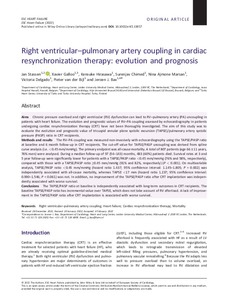Right ventricular-pulmonary artery coupling in cardiac resynchronization therapy: evolution and prognosis
Stassen Jan; Galloo Xavier; Hirasawa Kensuke; Chimed Surenjav; Ajmone Marsan Nina; Delgado Victoria; van der Bijl Pieter; Bax Jeroen J.
Right ventricular-pulmonary artery coupling in cardiac resynchronization therapy: evolution and prognosis
Stassen Jan
Galloo Xavier
Hirasawa Kensuke
Chimed Surenjav
Ajmone Marsan Nina
Delgado Victoria
van der Bijl Pieter
Bax Jeroen J.
WILEY PERIODICALS, INC
Julkaisun pysyvä osoite on:
https://urn.fi/URN:NBN:fi-fe2022081154676
https://urn.fi/URN:NBN:fi-fe2022081154676
Tiivistelmä
Aims Chronic pressure overload and right ventricular (RV) dysfunction can lead to RV-pulmonary artery (PA) uncoupling in patients with heart failure. The evolution and prognostic values of RV-PA coupling assessed by echocardiography in patients undergoing cardiac resynchronization therapy (CRT) have not been thoroughly investigated. The aim of this study was to evaluate the evolution and prognostic value of tricuspid annular plane systolic excursion (TAPSE)/pulmonary artery systolic pressure (PASP) ratio in CRT recipients.Methods and results The RV-PA coupling was measured non-invasively with echocardiography using the TAPSE/PASP ratio at baseline and 6 month follow-up in CRT recipients. The cut-off value for TAPSE/PASP uncoupling was derived from spline curve analysis (i.e. <0.45 mm/mmHg). The primary endpoint was all-cause mortality. A total of 807 patients (age 66 +/- 11 years, 76% men) were analysed. During a median follow-up of 97 (54-143) months, 483 (60%) patients died. Survival rates at 3 and 5 year follow-up were significantly lower for patients with a TAPSE/PASP ratio <0.45 mm/mmHg (76% and 58%, respectively), compared with those with a TAPSE/PASP ratio >= 0.45 mm/mmHg (91% and 82%, respectively) (P < 0.001). On multivariable analysis, TAPSE/PASP ratio <0.45 mm/mmHg (hazard ratio 1.437; 95% confidence interval: 1.145-1.805; P = 0.002) was independently associated with all-cause mortality, whereas TAPSE <17 mm (hazard ratio 1.237; 95% confidence interval: 0.990-1.546; P = 0.061) was not. In addition, no improvement of the TAPSE/PASP ratio after CRT implantation was independently associated with worse survival.Conclusions The TAPSE/PASP ratio at baseline is independently associated with long-term outcomes in CRT recipients. The baseline TAPSE/PASP ratio has incremental value over TAPSE, which does not take account of RV afterload. A lack of improvement in the TAPSE/PASP ratio after CRT implantation is associated with worse survival.
Kokoelmat
- Rinnakkaistallenteet [27094]
